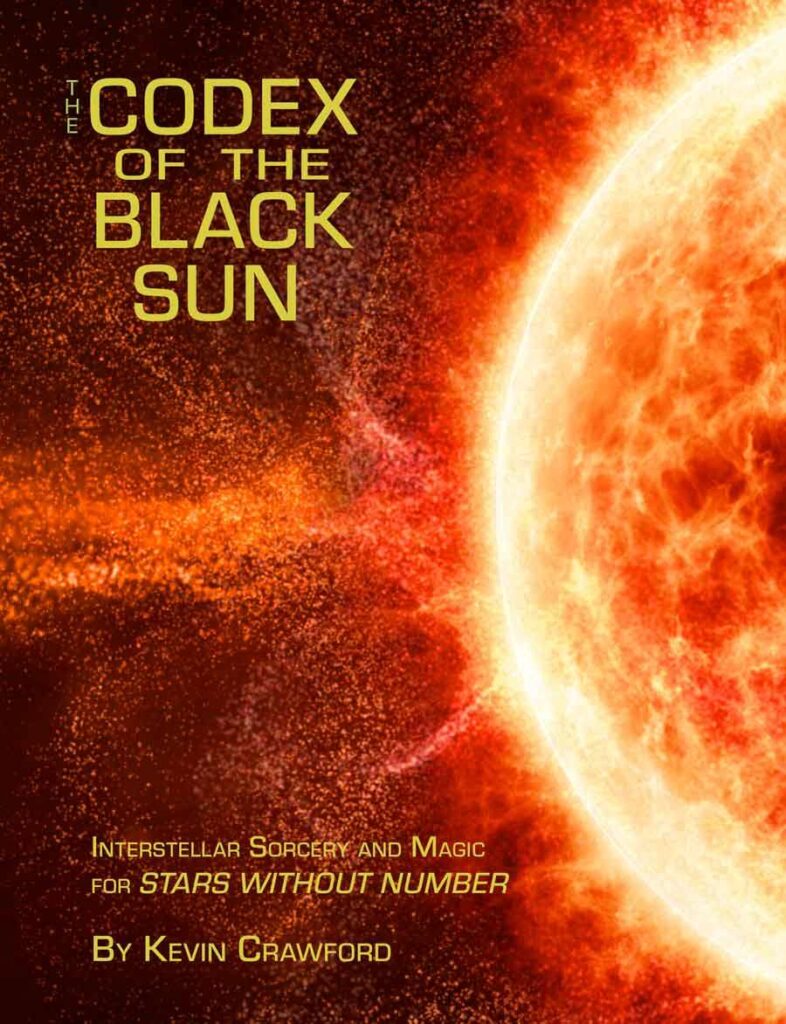Publisher: Sine Nomine Publishing
The Codex of the Black Sun: Sorcery for Stars Without Number is a supplement for the sci-fi roleplaying game Stars Without Number, that adds space magic and interstellar sorcery to the campaign. In this review, I will examine the content and presentation of the book, and give my overall impression and rating of it. I will also provide some recommendations and tips for using the book effectively.
Content
The book consists of 144 pages, divided into nine chapters.
- The first chapter introduces the history and background of arcane science in the Stars Without Number setting, explaining how magic was rediscovered after the Scream, a cataclysmic event that shattered interstellar civilization. The chapter also presents the main factions and organizations that practice or oppose sorcery in the galaxy, such as the Black Sun Cabal, the Order of Reason, and the Star Knights.
- The second chapter covers the rules and mechanics for spellcasting, arcanotech, and Shadow summoning. Spellcasting is the ability to manipulate reality with psychic power and arcane formulas. Arcanotech is the fusion of technology and magic, creating devices that can enhance or disrupt spellcasting. Shadow summoning is the art of conjuring creatures from a dark dimension called the Shadow, which can serve as allies or enemies.
- The third chapter introduces four new classes that can use sorcery: the Mage, the Arcanist, the Shadowmaster, and the Warlock. Each class has its own unique abilities, foci, and spells. The Mage is a versatile spellcaster that can learn spells from any school of magic. The Arcanist is a specialist in arcanotech, able to create and use devices that augment or counter magic. The Shadowmaster is a master of Shadow summoning, able to control and command creatures from the dark realm. The Warlock is a servant of a powerful patron, such as a demon lord or an alien god, that grants them spells and boons in exchange for their loyalty.
- The fourth chapter presents 100 new spells that can be used by any spellcasting class. The spells are divided into ten schools of magic, each with its own theme and flavor. The schools are: Abjuration (protection and defense), Alteration (transformation and manipulation), Conjuration (creation and summoning), Divination (perception and revelation), Enchantment (influence and domination), Evocation (energy and destruction), Illusion (deception and trickery), Necromancy (death and undeath), Translocation (movement and teleportation), and Universal (general and miscellaneous).
- The fifth chapter provides optional rules and guidelines for arcane research, development, and design. These rules allow players and GMs to create their own spells, arcanotech devices, Shadow creatures, and patrons. The chapter also includes tables and examples to inspire and facilitate the process.
- The sixth chapter describes sanctums and bases that mages and other heroes can create and use. Sanctums are places where mages can perform their arcane research, store their arcanotech devices, and summon their Shadow creatures. Bases are larger facilities that can house multiple sanctums, as well as other amenities such as labs, workshops, hangars, barracks, etc. The chapter explains how to create, maintain, upgrade, defend, and attack sanctums and bases.
- The seventh chapter offers a bestiary of 30 new creatures that can be encountered in the Stars Without Number setting. Some of these creatures are native to the Shadow realm, such as demons, shades, wraiths, etc. Others are products of arcane science gone wrong or right, such as golems, homunculi, zombies, etc. Each creature has its own stats, description, behavior, tactics, loot, etc.
- The eighth chapter presents four sample sectors that can be used as settings for Stars Without Number campaigns. Each sector has its own history, factions, planets, cultures, conflicts, etc. The sectors are: The Black Sun Sector (a sector dominated by sorcerers), The Fractured Sector (a sector torn by war between mages and technologists), The Lost Sector (a sector isolated by a mysterious anomaly), and The Shattered Sector (a sector ravaged by the Scream).
- The ninth chapter concludes the book with some advice on how to run a campaign with sorcery in Stars Without Number. The chapter discusses how to balance magic with technology, how to create interesting challenges and scenarios for spellcasters, how to integrate sorcery with other aspects of the setting, and how to handle common issues that may arise when using magic in sci-fi.
Conclusion
The Codex of the Black Sun: Sorcery for Stars Without Number is a supplement that adds space magic and interstellar sorcery to the sci-fi roleplaying game Stars Without Number. The book has a lot of content that offers a lot of options and variety for players and GMs who want to add sorcery to their Stars Without Number campaigns. The book is also creative and original in its approach to space magic and interstellar sorcery. The book is well-balanced and clear in its rules and mechanics.
I would recommend the book to anyone who is interested in adding sorcery to their Stars Without Number campaigns, or anyone who likes sci-fi and dark fantasy.
I would discourage anyone who is not interested in adding sorcery to their Stars Without Number campaigns, or anyone who dislikes sci-fi or dark fantasy.
Some suggestions or tips for using the book effectively are:
- Use sorcery sparingly and selectively in your campaigns. Don’t let sorcery overshadow or replace technology or psionics.
- Use sorcery creatively and imaginatively in your campaigns. Don’t limit yourself to the spells, devices, creatures, etc. provided by the book.
- Use sorcery as a source of conflict and drama in your campaigns. Don’t make sorcery too common or accepted in your setting.
- Use sorcery as a source of mystery and wonder in your campaigns. Don’t reveal everything about sorcery to your players.
- Use sorcery as a source of fun and adventure in your campaigns. Don’t take sorcery too seriously or grimly.
The Codex of the Black Sun: Sorcery for Stars Without Number on DrivethruRpg
